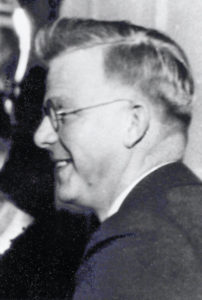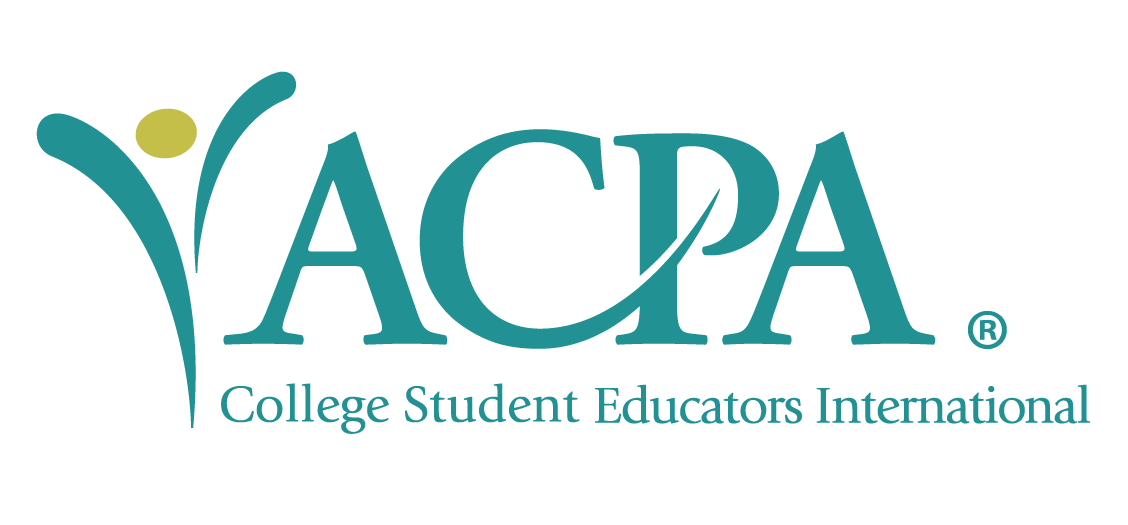Karl M. Cowdery (1933-1935)
Sixth President
Karl M. Cowdery was elected president of ACPA at the annual Business session on Saturday afternoon, February 25, 1933, in Minneapolis.  When elected he was Associate Registrar at Stanford University. Also, he was Academic Secretary of the university. Cowdery was 37 years old, father of two children, Richard and Dorothy, and a widower. His wife, Edythe Alice Graves, died approximately two weeks before his election.
When elected he was Associate Registrar at Stanford University. Also, he was Academic Secretary of the university. Cowdery was 37 years old, father of two children, Richard and Dorothy, and a widower. His wife, Edythe Alice Graves, died approximately two weeks before his election.
Cowdery was born in Oberlin, Ohio, where he attended the local schools and graduated from Oberlin College in 1915. He took a course at the Eugenics Record Office, Cold Springs Harbor, Long Island, and then he traveled cross country to Whittier (California) College where he took advanced psychological and biological work and did investigation statistical work in the study of heredity. For eight months during 1918 he served in the U.S. Army Medical Department as a psychological examiner.
At Stanford University he received the A.M. (1922) and Ph.D. (1926) degrees. The title of his dissertation was “An Evaluation of the Expressed Attitudes of Members of Three Professions (Medical, Engineering, and legal): A Study of a Positive Phase of Education.”
Cowdery’s name first appeared in the NAPPO membership list during 1930-31, when he was Assistant Registrar at Stanford. At the annual ACPA business meeting held on Thursday afternoon, February 18, 1932 at Hotel Washington in Washington, DC, the Nominating Committee made its report. Among the list of five vice-presidents accepted by vote of those in attendance was Cowdery’s name as vice-president for Personal Counseling.
During 1932-33, he and six others worked on their committee assignment to draft principles, functions, and standards report. Cowdery and his committee used as a guideline the first ACPA general committee report on principles, standards, and functions published in 1931. The committee was charged with four responsibilities: (1) define the terms in the field concerned, (2) prepare a statement of principles which ACPA might adopt as a basis for establishing that phase of personnel work in college, (3) prepare a statement of functions and techniques, and (4) prepare a statement of the methods of accrediting that division of the personnel bureau or department.
Cowdery and his committee members reported Thursday morning, February 23, 1933, the first day of ACPA’s tenth annual conference in Minneapolis. They met to present their report in Parlor N of the Nicollet Hotel prior to the luncheon. On Friday afternoon Cowdery led a roundtable discussion on Personal Counseling. During I the Saturday morning session conducted by the Teacher Placement division, he spoke on “Prognostic Devices for Use in Teacher Placement,” a research topic which surfaced at the round-table discussion of the Washington, DC conference in 1932. At the Saturday afternoon session when vice-presidents of the divisions gave ten-minute summary reports of the round-table discussions, Cowdery reported for his division on Personal Counseling.
At the Business session following the afternoon session, Cowdery was elected ACPA president for two years. Also, at the Business session, President Walters appointed Cowdery as a committee member to work with him and H.D. Kitson on a Coordinating Committee. Hopes were to continue the work of the intergroup planning committee which annually attempted to prevent overlapping of programs and activities of various organizations interested in guidance and personnel. The committee chaired by Walters met on several occasions and drafted a letter dated March 1, 1933, to President F.P. Keppel of the Carnegie Corporation requesting that his organization sponsor a coordination program among the national organizations. Keppel turned the letter over to the National Occupation Conference (NOG) leaders who called an organizational meeting for April 1933, subsequent to the appeals from several other organizations. Cowdery met with other organizational representatives to discuss possibilities of conference coordination at Cleveland in 1934.
President Cowdery and the ACPA program committee designed the eleventh annual convention, Wednesday through Sunday, February 21-25, 1934 to fit college students’ situations more closely in terms of their progress through school. Printed proceedings of the conference sent to all members consisted of General Organization, Admission and Orientation, Guidance and Adjustment Service, and Placement Service. Headquarters was the Statler Hotel. Several conference sessions focused on divisional titles. The opening general session was a joint meeting with other organizations at Hotel Cleveland. A luncheon meeting was held with NVGA and a joint luncheon was scheduled with PRF. The annual business meeting was held in conjunction with the annual ACPA dinner on Thursday evening, February 22, at the Statler. Cowdery spoke on “The American College Personnel Association—Its Form and Function.” Members present at the Business session voted to approve more cooperative action with other interested guidance and personnel groups.
The joint luncheon with other organizations was held Saturday, February 24, to discuss “Joint Planning for the Future.” At the conclusion of the luncheon, Cowdery proposed an organization called the “Council on Guidance and Personnel Associations” which should look into a more effective integration of aims and activities of the various organizations at the college level for a trial period of at least one year. Cowdery was still hopeful that a larger, all inclusive organization could be organized under ACPA banner. The 1933 ACPA membership list totaled 84.
On Friday, March 16, 1934, representatives of nine organizations, including ACPA, met in New York City to work out final details for the American Council of Guidance and Personnel Associations (ACGPA). The agency of associations was formed to coordinate convention activities and programs. The chair of the ACPA Program Committee met with the program chairs of ACGPA member organizations to plan the 1935 conference in Atlantic City. Meetings were scheduled for Wednesday through Sunday, February 20-24, for the twelfth annual convention with headquarters for ACPA in Haddon Hall. Sixty-two people paid registration fees of one dollar.
The ACPA program was arranged into subject areas under the titles of the five divisions. In addition, some ACPA members met with the ACGPA Delegate Assembly for opening-day ceremonies and attended a “United Front” luncheon of guidance and personnel organizations prior to the first ACPA divisional meeting scheduled for Wednesday afternoon with Cowdery presiding. He presided at the annual ACPA dinner Thursday evening, and he was scheduled to attend a joint reception to meet the officers of all the organizations later that night. On Friday evening, Cowdery served as leader of a round-table discussion on specific Problems of Policies, Procedures and Pressures in College Work.
At the annual ACPA Business session held prior to the dinner on Thursday, February 21, the Nominating Committee chaired by Bradshaw listed Cowdery as vice-president of the Educational Counseling division. Cowdery brought to the Business session a proposal from NOC with the ACPA president serving as an ex-officio member. After discussion the members voted not to accept the NOC invitation. The financial report of the treasurer indicated that ACPA had 111 members during 1934-35.
A rare blood disease was discovered at the time he was commissioned in the Navy during World War II. He died at his home in Stanford when he was 49 years old, survived by his two children and his parents.
